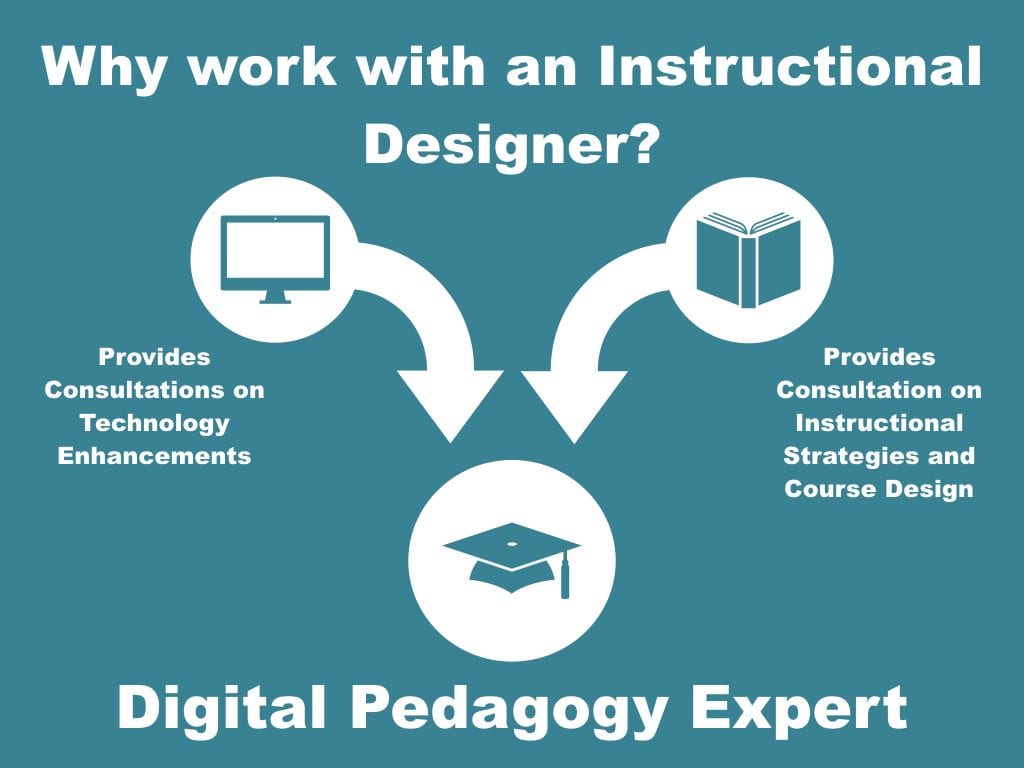WHAT IS AN INSTRUCTIONAL DESIGNER?
Perhaps you have worked with a teaching consultant on developing your online or face-to-face course. Teaching consultants can provide instructors with recommendations on how to present content effectively, how to develop appropriate assessments, and how to create measurable learning outcomes.
Have you ever tried to implement a new technology tool in your online or face-to-face course? You may have worked with an educational technologist, someone who will provide you with strategies to implement technology tools to enhance learning.
As an instructional designer, I help to bridge the gap between services offered by teaching consultants and by educational technologists. I strongly feel that instructional designers should be viewed as digital pedagogy experts that provide consultations both on pedagogy and technological choices for course design.
WHAT DO I BRING TO THE ROLE?
Leveraging my background
My content area background is in STEM. Having this background really has helped me considerably in the course design process for STEM courses, as I find that the faculty and I can speak the same language about their content for those courses. Furthermore, I often try to leverage my experience in Biology Education Research (BER) to guide the development of assignments and assessments in these courses.
More broadly, I rely on my solid background in discipline-based education research (DBER) and in college teaching to further enhance the course design process. In my role, I feel that keeping up-to-date on the current literature in both discipline-based education and educational technology is essential. I often form the backbone for my course design choices based upon what is currently discussed in the literature with an eye on the gaps. Often times, these “gaps” are not a problem because it is in those areas where I like to work with faculty to develop new and innovative interventions and assess their efficacy.
The Project Manager and “Glue” of the Team
As an instructional designer, I find myself serving as the project manager and “glue” that holds together a team of collaborators consisting of faculty, video and multimedia specialists, and Carmen tool specialists. What makes my course design efforts so effective is my ability not only to leverage the talents of everyone involved in the course design process, but also to help every individual involved successfully complete their individual part.
With faculty, I strive to envision opportunities to enhance online courses with a rich variety of learning experiences–particularly through multimedia components. By working closely with our video and multimedia specialists, I have been instrumental in the creation of a vast array of meaningful course additions such as
- Light board lectures,
- Engaging guest interviews and lectures,
- Laboratory walkthroughs and demos,
- New students resources for conducting research,
- Interactive Infographics,
- Multimedia Learning Objects to teach data literacy, and
- Interactive Branching Activities that allow students to explore the ramifications of their choices (e.g. in leadership scenarios, case management scenarios, etc.)
All of the aforementioned course additions would not be possible without strong collaborative and project management skills. As an instructional designer, first I work closely with a faculty to identify areas of the course that can be enhanced through multimedia components and then connect them with appropriate team members to work as a true team to successfully create those components.
CONTRIBUTIONS TO COURSE DESIGN
In my portfolio, I would like to give you the opportunity to see some of the instructional materials that faculty have created as a result of working with me as an instructional designer.
You can learn more about:
- My approach to project management,
- My critical course design feedback,
- Examples of online course organization,
- Student success resources for online students,
- Ways to diversity lecture content for an online course,
- Authentic assignments that provide meaningful application of knowledge for an online course, and
- Adding interactivity to an online course.
